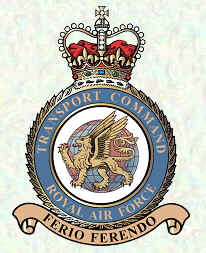
RAF Transport Command was a Royal Air Force command that controlled all transport aircraft of the RAF. It was established on 25 March 1943 by the renaming of the RAF Ferry Command, and was subsequently renamed RAF Air Support Command in 1967.

A Nissen hut is a prefabricated steel structure for military use, especially as barracks, made from a half-cylindrical skin of corrugated iron. Designed during the First World War by the American-born, Canadian-British engineer and inventor Major Peter Norman Nissen, it was used also extensively during the Second World War and adapted to the similar Quonset hut in the United States.

RAF Andover is a former Royal Flying Corps and Royal Air Force station in England, 2 miles (3.2 km) west of Andover, Hampshire. As well as RFC and RAF units, units of the Aviation Section, U.S. Signal Corps, Royal Canadian Air Force, United States Army Air Forces, and the Air Transport Auxiliary were also stationed at the airfield.
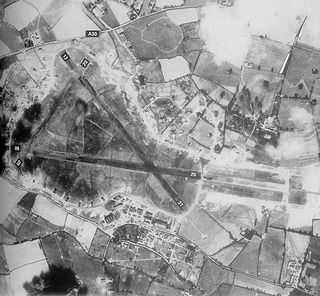
Class A airfields were World War II military installations constructed to specifications laid down by the British Air Ministry Directorate-General of Works (AMDGW). Intended for use by heavy bombers and transports, they were the standard air base design for the Royal Air Force as well as U.S. Army Air Forces units operating from the UK.

Royal Air Force Bottisham or more simply RAF Bottisham is a former Royal Air Force station located 5 miles (8.0 km) east of Cambridge, Cambridgeshire, England.
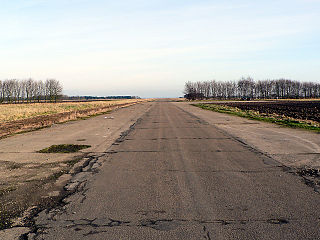
Royal Air Force Metheringham or more simply RAF Metheringham is a former Royal Air Force station situated between the villages of Metheringham and Martin and 12.1 mi (19.5 km) south east of the county town Lincoln, Lincolnshire, England.
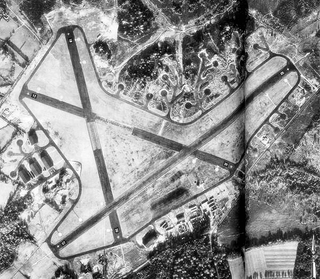
RAF Holmsley South is a former World War II airfield in Hampshire, England. The airfield is located approximately 5 miles (8.0 km) northeast of Christchurch, Dorset; about 90 miles (140 km) southwest of London

Royal Air Force Chilbolton or RAF Chilbolton was a Royal Air Force station in Hampshire, England. The airfield was located in Chilbolton approximately 4 miles (6.4 km) south-southeast of Andover, about 62 miles (100 km) southwest of London

RAF Westonzoyland is one of the country's oldest airfields being established in the early 1920s. Somerset, England. The airfield is located approximately 4 miles (6.4 km) east-southeast of Bridgwater; about 125 miles (201 km) west-southwest of London.
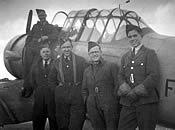
Royal Air Force Condover or more simply RAF Condover is a former Royal Air Force Flying Training Command airfield and air navigation training establishment between August 1942 and June 1945, unusually for both fighter and bomber crews at different times. Located on the southern outskirts of Condover village in Shropshire, 4.9 miles (7.9 km) south of the county town Shrewsbury.
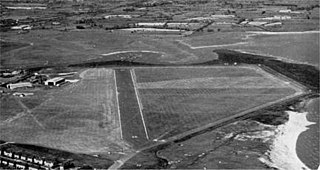
Royal Air Force Pengam Moors or more simply RAF Pengham Moors is a former Royal Air Force station and maintenance unit (MU), located on the Pengam Moors area of Tremorfa, 2 miles south east of Cardiff city centre in Wales from June 1938 to January 1946. It was also known as RAF Cardiff)

Royal Air Force Cammeringham or more simply RAF Cammeringham was a Royal Air Force station used by RAF Bomber Command between 1940 and 1945 and the Polish Air Force until 1946. The airfield was located between the A15 and B1398 roads, 10.3 mi (16.6 km) north of the city Lincoln, Lincolnshire, England and due east of the village of Ingham.
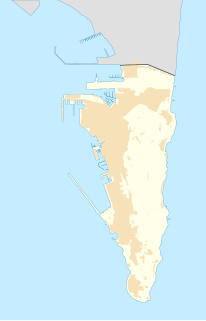
Middle Hill Battery is an artillery battery in the British Overseas Territory of Gibraltar. It is located on Middle Hill, at the northeastern end of the Upper Rock Nature Reserve, just south of Green's Lodge Battery and Rock Gun Battery. The emplacement dates to 1727, when a single gun was mounted. By the turn of the twentieth century, six 10-inch rifled muzzle-loading guns were present at Middle Hill Battery. Other buildings documented at that time as part of the battery complex included the Nursery Hut and the Middle Hill Group, the latter a cluster of buildings which perched on the cliff edge. An anti-aircraft Bofors gun had been installed at the battery by the Second World War. After the war, the area transitioned to use as a Ministry of Defence aerial farm. In 2005, the battery and surrounding area were transferred to the Government of Gibraltar. The site is now managed by the Gibraltar Ornithological and Natural History Society.

The Quetta Memorial Precinct is a heritage-listed Anglican church precinct in Douglas Street, Thursday Island, Shire of Torres, Queensland, Australia. The precinct comprises the All Souls and St Bartholomew's Cathedral Church, the Bishop's House, and the Church Hall. The precinct was built as a memorial to the 134 lives lost in the shipwreck of the RMS Quetta on 28 February 1890. The church was designed in 1892–1893 by architect John H. Buckeridge. It was added to the Queensland Heritage Register on 27 July 2001.

Royal Air Force Wing or more simply RAF Wing is a former Royal Air Force bomber training station, situated just west of the village of Wing, in the Aylesbury Vale district of Buckinghamshire, established on the site of a small aerodrome.

WWII RAN Fuel Installation is a heritage-listed former fuel depot and now arts centre at Collins Avenue, Edge Hill, Cairns, Cairns Region, Queensland, Australia. It was built in 1943. It was added to the Queensland Heritage Register on 2 February 2007.

A Pickett-Hamilton fort is a type of hardened field fortification built in Britain during the invasion crisis of 1940–1941. The Pickett-Hamilton fort was designed to be lowered into the ground while it was not in use, to become inconspicuous and not interfere with the passage of taxiing aircraft or other vehicles. The fort could be raised to about 2 feet 6 inches (0.76 m) above ground level where it would be a physical impediment to aircraft and vehicles and from where a small crew could fire with rifles or light machine guns.

RAF Charmy Down is a former Royal Air Force (RAF) station in Somerset, England, approximately 3 miles (4.8 km) north-northeast of Bath and 96 miles (154 km) west of London.
James Hardress de Warrenne Waller, was an Irish inventor and engineer who developed building systems using concrete known as Nofrango and the Ctesiphon system.






















